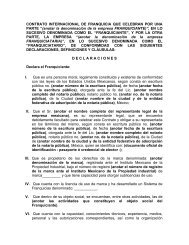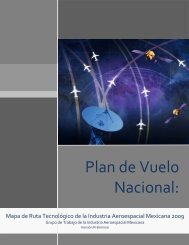MINING IN MEXICO S - ProMéxico
MINING IN MEXICO S - ProMéxico
MINING IN MEXICO S - ProMéxico
You also want an ePaper? Increase the reach of your titles
YUMPU automatically turns print PDFs into web optimized ePapers that Google loves.
32 Negocios<br />
work and this is one of our main competitive<br />
advantages, as producers only have to bring<br />
the bare essentials to Mexico. They can travel<br />
with smaller teams and they can hire the rest<br />
of their people here. Films like Apocalypto<br />
[Mel Gibson, 2006], The Legend of Zorro<br />
[Martin Campbell, 2005] or Troy [Wolfgang<br />
Petersen, 2004] are just some examples of<br />
productions that employed Mexican labor<br />
extensively,” says Hugo Villa.<br />
IMC<strong>IN</strong>E’s statistics reveal that US productions<br />
most frequently use Mexico for filming,<br />
due to its obvious geographical proximity.<br />
France and Spain are the European countries<br />
which predominantly choose to film in Mexico,<br />
the latter for language reasons. For the<br />
same reason, a number of Latin American<br />
countries like Argentina, Brazil, Uruguay, Cuba<br />
and Bolivia, choose Mexican locations.<br />
This variety of countries that choose<br />
Mexico to film their productions seems to<br />
be growing at the same pace as the locations<br />
themselves. “Local and state<br />
governments are taking increasing<br />
interest in the importance<br />
of the film industry, not only<br />
for their economies but also for<br />
the promotion of tourism that<br />
arises from people seeing these<br />
places on big screens around the<br />
world,” says Hugo Villa.<br />
And so while Durango was once ‘the<br />
king’ of American Western movies, today<br />
major film producers favor several states<br />
across Mexico. Their preferences are not<br />
only shaped by the climate, geographical terrain<br />
or suitable period sets but also by infrastructure<br />
around the location which is often<br />
a determining factor for whether filming is<br />
to take place in a specific place or not.<br />
“Currently Mexico City is top choice for<br />
foreign productions. You could safely say<br />
that 70% of films produced in Mexico take<br />
place in the country’s capital, partly due to<br />
the city’s infrastructure and airport facilities<br />
but also due to the city government’s work in<br />
supporting film productions on their patch,<br />
with new legislation and regulations making<br />
it very clear how to go about the process,” explains<br />
Hugo Villa.<br />
Also, Mexico City has an ace up its sleeve.<br />
The Estudios Churubusco film studio is located<br />
in the Mexican capital, with sets suitable<br />
for large-scale productions that are<br />
unique throughout Latin America and with<br />
industry-related services that easily match<br />
the quality of other international studios.<br />
Even so, states like Morelos, Puebla, Veracruz<br />
and Zacatecas seem to be making their<br />
presence felt, after years of the desert and<br />
beach locations in states like Durango and<br />
Baja California being the star attractions.<br />
This is an area in which IMC<strong>IN</strong>E, as a national<br />
institute, is working hard.<br />
“We go to all the festivals we can, both in<br />
Mexico and abroad, to promote the country<br />
as a ‘film destination’ offering a whole series<br />
of benefits […] and of course we invite those<br />
in charge of film promotion at state government<br />
level. Little by little, this work is beginning<br />
to pay off,” says Hugo Villa.<br />
Every year Mexico is host to at least ten or<br />
twelve large foreign productions. Each one<br />
spends between 8 million and 10 million usd,<br />
representing a profit of between 120 million<br />
and 130 million usd.<br />
And They Filmed Happily Ever After<br />
It is not only the large, 100% foreign productions<br />
that generate revenue for Mexico. Coproduction<br />
is a formula that is increasingly<br />
applied in the global market and in Mexico.<br />
The IBERMEDIA program in Spain,<br />
for example, created in 1997, has successfully<br />
raised funds to provide an incentive for<br />
Spanish and Latin American producers to<br />
work on co-productions.<br />
But this is not the only way. The Mexican<br />
film industry is always looking for ways to<br />
encourage Mexican filmmakers and producers<br />
to “throw their hats into the ring.” Increasingly,<br />
alliances with foreign colleagues<br />
are being formed, resulting in benefits for<br />
the film industries of the countries involved.<br />
In Mexico, under Article 226 of the Income<br />
Tax Law, producers can make films<br />
with exclusively Mexican content, but they<br />
can also use this financing for co-productions<br />
with content from other countries. No<br />
small incentive.<br />
“This investment fund, which does not<br />
come from the public purse but instead is<br />
paid by the taxpayer himself, has strengthened<br />
Mexican film-makers and producers<br />
and converted them into major players within<br />
the international film scene, especially<br />
in Latin America or those countries with<br />
similar-sized industries to the Mexican one,”<br />
says Villa.<br />
This fund currently has a total of 500 million<br />
pesos to invest in productions involving<br />
Mexicans. Those who take advantage of this<br />
incentive almost always have 50% in private<br />
investment, a considerable amount for Mexico<br />
if the film is made in this country. That amount<br />
often doubles the initial funding, meaning that<br />
through this mechanism alone, approximately<br />
$1 billion pesos remain in Mexico.<br />
According to IMC<strong>IN</strong>E, that is not all. Every<br />
year Mexico is host to at least ten or twelve<br />
large foreign productions. Each one spends<br />
between 8 million and 10 million usd, representing<br />
a profit of between 120 million and 130<br />
million usd.<br />
The Challenges Behind The Cameras<br />
It is not all plain sailing in the film scene,<br />
however. Like the movies themselves, which<br />
compete with each other to position themselves<br />
as the latest “box-office hit,” the competition<br />
between potential locations and<br />
national industries to produce a major film<br />
is tough. Mexico is aware of the<br />
challenge.<br />
“We are competing, for example,<br />
with incentives such as those<br />
offered by New York City, which<br />
recently announced a fund of 490<br />
million usd for those filming in<br />
New York locations, or by Puerto<br />
Rico, which returns to foreign producers<br />
45% of their expenditure in their territory.<br />
In contrast, Mexico offers a VAT refund.<br />
Also, although all Mexican states offer their<br />
own particular attractions for film productions,<br />
Mexico’s natural attractions could be<br />
optimized and improved a lot more in order to<br />
take full advantage of our natural assets,” concludes<br />
Hugo Villa.<br />
Even with these challenges and with parts<br />
of the film machinery still needing a little oil,<br />
there is something about Mexico that captures<br />
people’s hearts and fascinates them in the<br />
same way a good movie does.<br />
Otherwise it would be hard to explain why<br />
so many filmmakers choose to return to film in<br />
Mexico. This is by no means an isolated phenomenon.<br />
The latest saga in this “film love”<br />
will be in 2010 when Mel Gibson will return to<br />
film in Veracruz, where he made his box-office<br />
smash Apocalypto.<br />
How I Spent My Summer Vacation is a film<br />
written and produced by Gibson himself, once<br />
again promising controversy and therefore likely<br />
to attract large audiences. Moviegoers around<br />
the world will see Mexico’s natural beauty projected<br />
before their eyes onto the big screen. n

















